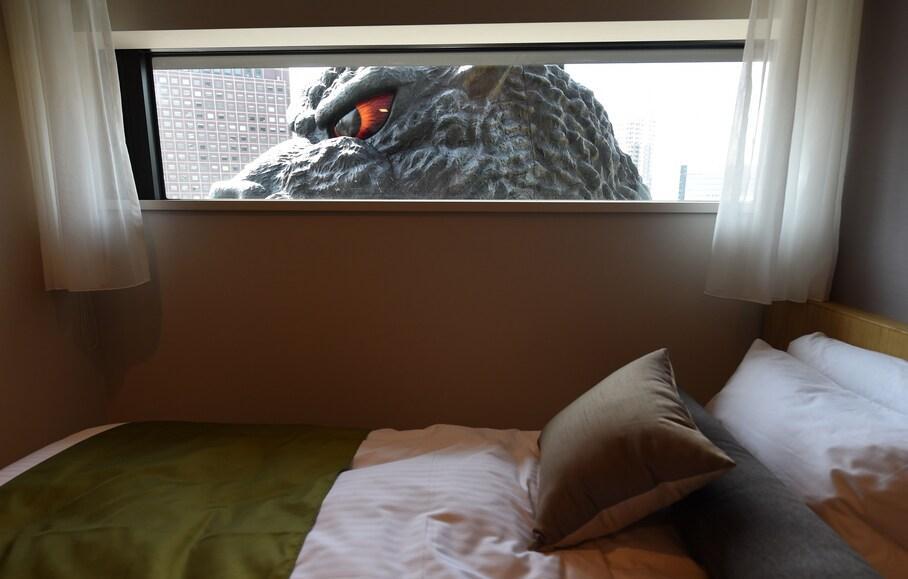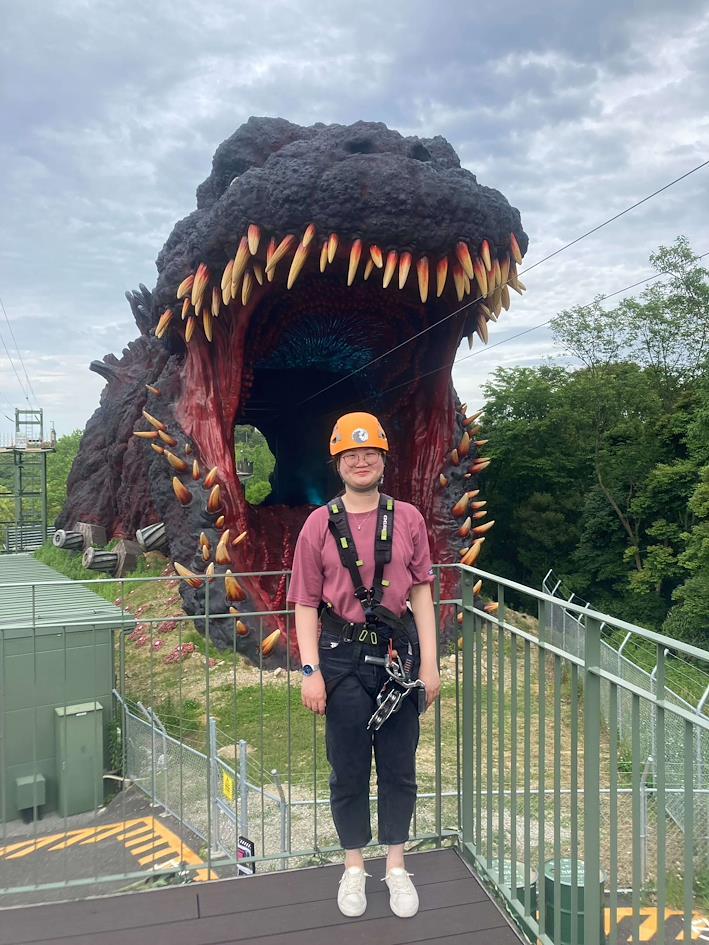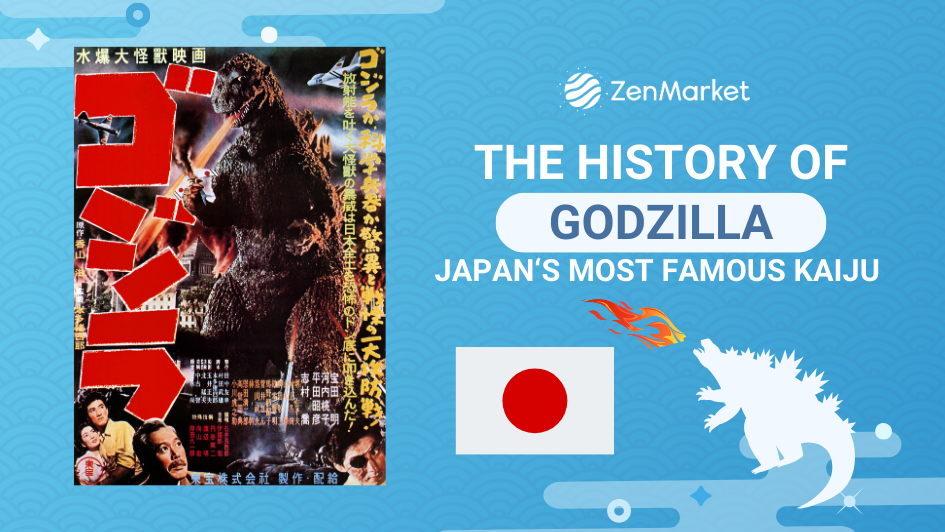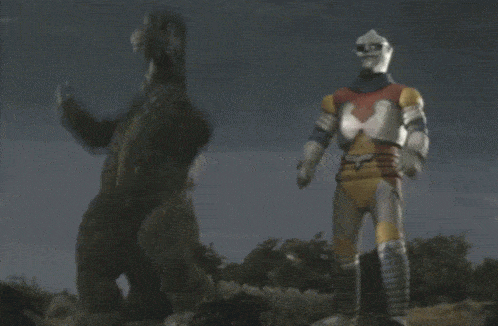[ad_1]
Japan is well-known for introducing the Kaiju genre to the world. They brought giant monsters to the big screen and have created many generations of Kaiju lovers. Their most famous creation is the King of the Monsters himself, Godzilla.
Godzilla’s rich history tells the story of post-war Japan’s emergence into the modern world. He has become a cultural icon that would embody Japan’s fears, strengths, and ideals. He has endured and represented many of the ideas and issues of the different generations of Japan.
Today, Godzilla has managed to break out of its natural habitat and has become a global sensation. And while he is a uniquely Japanese creation, he continues to help shape and tell the stories of our world.
In this article, we will be taking a deep dive into Godzilla’s history. We will talk about his origins, the people who made him, the techniques used in the early days of Godzilla movie making, and the deeper meaning of the Godzilla movies.
What is Godzilla?
Godzilla is a giant fire-breathing monster created by Toho. He has appeared in over 30 movies and multiple comic books over the past 70 years. He first stomped his way into Japanese cinemas in 1954 and since then, he has appeared in multiple Godzilla movies, TV shows, anime, and manga. His unique Japanese identity makes Godzilla completely different from all the giant monsters that came before and after him.
Godzilla isn’t just a random monster that comes to destroy Japan. There is a deeper meaning to his birth and existence. In the many movies that featured Godzilla, he has come to represent many of Japan’s fears and ideals. He represents the dangers of the atomic bomb, but he also represents Japan’s greatest strength and capacity for technological innovation and heroism.
In addition, Toho and the Godzilla franchise have contributed so much to Japanese filmmaking and culture. Godzilla isn’t the first film to feature a giant monster. King Kong (1933) and Tthe Beast from 20,000 Fathoms (1953) came up with the idea first. However, Godzilla is truly the first one of its kind. A monster movie with a deeper meaning, spawning deep interest that has led to many incarnations. In many ways, Godzilla is the godfather of the Kaiju genre.
The Godzilla franchise also pioneered Japanese special effects, known as “Tokusatsu”, many of the techniques used in Godzilla films, such as “Suitmation” (スーツメーション), have been used in many future Japanese projects, including “Ultraman” and the “Super Sentai Series”. In fact, Godzilla has a direct impact on the Ultraman series. Many of the suits used in Godzilla films were later repurposed in the Ultraman series.
The Cultural Importance of Godzilla
When was Godzilla Made?
Today, Godzilla is best known as an anti-hero who often fights other Kaiju to defend the earth. Godzilla’s depiction in the Heisei-era films from the mid-80s to early 90s has come to define the character’s image. Even modern interpretations, such as Legendary’s Monsterverse Godzilla, pays homage to Heisei-era Godzilla. However, many might be surprised to learn that Godzilla’s true origins are much darker.
Toho created Godzilla in 1954. At the time, the Japanese movie industry was very different. Japanese movie studios were still recovering from the Second World War. American military occupation of the country had only recently ended, thus lifting the heavy censorship of Japanese literature and film.
In the early 1950s, Toho’s top-grossing films were mostly war-related movies. With the success of “Eagle of the Pacific,” directed by Ishiro Honda and produced by Tomoyuki Tanaka, Toho had their eyes set on another war-themed project.
Eikō no Kage ni (In the Shadow of Glory) was supposed to be Toho’s next big hit. The idea was to create a film about post-war Japan and Indonesia’s relationship. However, given Indonesia’s anti-Japanese sentiments at the time, Tanaka’s crew was denied access to the country.
Tanaka suddenly came up with an alternative during his flight home to Japan. While staring at the sea, he wondered. “What if a giant monster suddenly appeared from the ocean?” The idea then came that Toho’s next big hit should be a monster movie, similar to “The Beast from 20,000 Fathoms,” released two years prior.
However, Ishiro Honda was not content with creating just another monster movie. He wanted to create a film with a strong message based on the horrors he experienced on the battlefield.
Inspiration for Honda’s 1954 Godzilla Film
Ishiro Honda and many of his colleagues served in the Japanese military during the war. During the latter part of the conflict, Honda was imprisoned in China. Upon his return, he saw the aftermath of the bombings of Nagasaki and Hiroshima. Honda was told that no grass would grow there for the next 72 years. The sight of the damages of the atomic bomb heavily influenced Honda’s messages in his upcoming film.
Another major event in 1954 was the Daigo Fukuryū Maru (Lucky Dragon No.5) incident. The Japanese fishing boat was caught in the blast radius of America’s hydrogen bomb testing during “Operation Castle.” As a result, 23 men were contaminated by nuclear fallout.The event reignited Japan’s fear of nuclear weapons. Given these two events, Honda did not hesitate to make his message loud and clear in Godzilla.
Creation of Godzilla
The unfortunate nuclear weapons-related events in the last seven years set the stage for Godzilla’s conception. What was left was the actual monster design. There are many stories within Toho about how they came up with Godzilla’s name and physical appearance.
However, the most accepted one was that “Gojira” was a combination of the Japanese words gorilla (Gorira/ゴリラ) and whale (Kujira/鯨). Godzilla’s physical appearance was based on a loose depiction of a dinosaur.
However, Godzilla’s design heavily emphasized the negative effects of nuclear bombing. Godzilla’s skin heavily resembled the burns of nuclear blast survivors, and his head looked like the mushroom cloud from a nuclear blast. Teizō Toshimitsu and Akira Watanabe designed Godzilla under the supervision of special effects director Eiji Tsuburaya.
Once they were satisfied with Godzilla’s look, the next challenge was bringing Godzilla to life. At the time, stop motion was the preferred animation technique, as it was used in King Kong and the Beast from 20,000 Fathoms. However, due to time constraints, Eiji Tsuburaya had to come up with something else.
He then came up with the idea of using a miniature set and a man-operated monster suit. Optical compositing technique was also used to stitch together Godzilla and the human characters.
Godzilla Suit and the Birth of Suitmation
The final design for Godzilla’s suit was named the ShodaiGoji suit. The team faced many challenges with the suit’s creation. During post-war Japan, the lack of raw materials, such as latex, led the team to resort to ready-mix concrete. There were two revisions of the suit. “Suit No. 1” was deemed too heavy. Thus, a lighter “Suit No.2” was also made. But the second Godzilla suit was still heavy at 100 kilograms. A hand-operated version of the suit’s upper half was also made for close-up shots.

(Photo Source: Classic Godzilla Actors Recall Horror Stories From Wearing the Suit: “We Risked Our Lives” by HoolyWood Reporter)
Haruo Nakajima, who managed to impress Director Honda and producer Tomoyuki Tanaka with his brave stunts in Eagle of the Pacific, donned the Godzilla suit. Even for the brave Nakajima, operating the Godzilla suit proved challenging. Nakajima managed to complete filming despite passing out several times on set.
Godzilla as a Part of Japanese Culture
Throughout Godzilla’s run in Japanese cinema, Godzilla has become an integral part of Japanese culture. Godzilla’s original depiction as a metaphor for the atomic bomb is still very powerful today. Looking back at Honda’s work in Godzilla 1954 allows today’s viewers to experience what Japan went through during the detonation of the atomic bomb in Hiroshima and Nagasaki. Sure, there was no giant monster rampaging through the city. However, both the long-term effects and short-term effects of the bomb were just as bad as Godzilla’s destruction.
More importantly, the direct effects of Godzilla’s attack on the Japanese people in the film were an almost perfect recreation of what Japanese atomic bomb victims had to go through. In many ways, Honda’s Godzilla film is a time capsule that shows post-war Japan’s fears of the atomic bomb. The fear that Godzilla brought to Japan wasn’t only his cultural impact on the country.
His representation as Japan’s hero against threats has also inspired heroism in Japan. The films have always depicted the Japanese people as resilient to any threat. So even though there is no real-life Kaiju to attack or save Japan, the country’s capacity to overcome the odds is the real-life representation of Godzilla. Lastly, Godzilla has endured and adapted over the last seventy years. And despite being shelved and put on hiatus by Toho, the King of the Monsters always returns.
According to Japanese illustrator Yuji Kaida and animator Eiji Yamamori, Godzilla created a chain reaction that led to an endless cycle of creation. Godzilla has appealed to many generations. The youth of the previous generation who experienced Godzilla became the professionals who made the next generation of Godzilla films.
/cdn.vox-cdn.com/uploads/chorus_image/image/63927150/helpinggodzilla.0.1535739481.0.jpg)
(Photo Source: Eiji Tsuburaya made Godzilla come alive — and it changed film forever by Vox)
Initially, Godzilla’s appeal to children was his fun destruction and onscreen fights with other Kaiju. However, as they grew older, they started seeing the deeper message in every Godzilla film. As adults, the films they helped create would explore issues in the modern world. As proof of this endless cycle of creation, the directors of today’s Godzilla films are either fans of Godzilla movies or the Kaiju genre.
Also Read: A COMPLETE HISTORY OF COMIKET
Godzilla Historical Timeline
1954 – 1975 Ishiro Honda’s Gojira and the Showa Era
In 1954, Ishiro Honda, Eiji Tsurubaya, and Tomoyuki Tanaka would forever change Japanese cinema with the release of Godzilla. The film’s dark depiction of the effects of the nuclear bomb initially received criticism for exploiting the recent Daigo Fukuryū Maru incident.
However, Japanese people soon came to appreciate Honda’s masterpiece. With the success of Godzilla in 1954, multiple sequels would be produced, creating the Showa era of films. Godzilla became one of the first cinematic universes complete with interconnected films and recurring characters.
However, Godzilla’s early days weren’t always perfect. Toho had no clear direction and instead relied on elements that worked on previous releases. As a result, Godzilla became less about Honda’s political messages and more about giant monsters fighting each other. Godzilla also progressively transformed into a superhero made to appeal to children. Despite the disdain of Honda and Tanaka, they couldn’t do much as the world rapidly changed around them.
Fierce competition from TV shows also pressured Tanaka to move into the lighthearted direction that the franchise took in the 60s and 70s. Despite how ridiculous the later Showa era films were, Honda never strayed away from his vision. And in essence, he managed to transform Godzilla from Japan’s biggest fear to one of its greatest strengths.
In many Showa-era films, evil Kaiju and alien invasion plots were common. In essence, these can be seen as human or supernatural threats against Japan. And in this case, Godzilla represents Japan’s strength to overcome any kind of obstacle. Unfortunately, Ishiro Honda and the rest of Toho’s crew could not salvage Godzilla’s declining popularity in the 1970s. Terror of Mechagodzilla would be the final film in the Showa era after failing at the Japanese Box Office.
1984 – Return of Godzilla and the Heisei Era
Despite Godzilla being put on hiatus in 1975, Toho was still very interested in bringing back the character. However, producer Tomoyuki Tanaka did not know what kind of Godzilla movie would appeal to modern 1980s Japan. He also didn’t know if the timing was right for Godzilla’s return. In the early 1980s, multiple scripts and ideas for a new Godzilla film were proposed. The most notable unproduced scripts include a colored remake of 1954 Godzilla, Godzilla fighting against the devil, and Godzilla fighting against a vampire like Kaiju.
The early 1980s was also the first time Toho played around with the idea of allowing American studios to produce Godzilla. In 1983, Director Steve Miner (Friday the 13th, Lake Placid, Halloween) approached Toho for a big-budget American Godzilla film. Miner’s Godzilla project was titled Godzilla: King of the Monsters in 3D. The film was planned to feature A-List American actors and full stop motion animation instead of Toho’s traditional Suitmation.
The film already had a full script and a redesigned Godzilla model. But unfortunately, the project was deemed too expensive by American studios. Miner’s Godzilla film was soon officially canceled after being rejected by most big-name western movie studios. In the end, Toho decided to make Godzilla themselves. However, Godzilla’s return to Japanese cinemas wasn’t in the form of a superhero fighting evil Kaiju. Instead, Tomoyuki Tanaka returned to Godzilla’s roots by creating a direct sequel to Ishiro Honda’s 1954 classic.
As directly stated by Tomoyuki Takana, “Godzilla is the son of the atomic bomb. He is a nightmare created out of the darkness of the human soul. He is the sacred beast of the apocalypse. As long as the arrogance of human beings exists, Godzilla will survive.” Tanaka also stated that turning Godzilla into a lighthearted hero was a mistake and was directly responsible for the character’s decline in the 1970s. However, Godzilla’s return in 1984 didn’t simply paint him as a mindless rampaging monster representing the dangers of nuclear weapons.
Toho’s depiction of the 1980s and early 1990s Godzilla created the popular anti-hero we know today. In an interview with Toho special effects artist Koji Hashimoto, he stated, “I wanted viewers to feel sorry for Godzilla, and I think I succeeded. The existence of Godzilla itself is a dilemma. Godzilla is a living conflict of evil and sadness.”
Godzilla movies would continue to be successful until the end of the Heisei era films in 1995. With Godzilla’s transformation into a serious and complex character that represented many real-world issues, Godzilla became embedded in the collective consciousness of the Japanese people.
1995 – 1999 “The Death of Godzilla” and Birth of American Godzilla
After a successful run in the 1980s and 1990s, Toho ended the current Heisei series of films. The seventh entry in the series, Godzilla vs. Destroyah, saw the death of Godzilla due to his nuclear meltdown. The 1995 film wasn’t the first on-screen death of Godzilla.
However, what was surprising was that Toho was serious about retiring the King of the Monsters. They even held a public funeral for fans to mourn Godzilla’s on-screen death. After the end of the Heisei era, Toho once again explored bringing Godzilla to western audiences. Toho allowed Sony Pictures to make their version of Godzilla. After multiple rewritten scripts and changes in production staff, Sony’s Tristar Pictures finally decided to work with Roland Emmerich, who previously directed the highly successful “Independence Day.”
(Video: Godzilla’s Funeral 1995 – After his Meltdown in Godzilla vs. Destroyah – Rare Toho Archives)
Unfortunately, the American version of Godzilla’s cast and crew were not fans of Toho’s original work. They believed all Godzilla movies were similar. And in essence, Godzilla was simply about two guys wearing rubber suits fighting each other. Instead of paying homage to the source material, Emmerich created his version of Godzilla.
Many fans even cited that Emmerich did not care about Godzilla’s legacy. He was simply looking for an excuse to create another disaster movie. During Toho and Emmerich’s meeting in 1996, Toho was made aware of the many changes to Godzilla’s design, characteristics, and story. And despite Toho’s objections, they ultimately agreed since it was their best shot at reaching the American movie market.
In the end, Emmerich’s Godzilla film was a complete failure. Neither Godzilla fans nor Toho acknowledge the film as a proper version of Godzilla. It was even mocked in later Godzilla films and was directly confronted and defeated by the real Godzilla in the 2004 film “Godzilla: Final Wars.”
With Godzilla’s reputation on the line, Toho decided to once again make Godzilla movies themselves. The Godzilla films from 1999 to 2004 would later be known as the Millennium era. And while these films didn’t reach the same heights as the Heisei era, they did an excellent job honoring the King and introducing him to a new generation.
2004 – Godzilla 50th Anniversary
In 2004, Toho celebrated Godzilla’s 50th Anniversary by releasing “Godzilla: Final Wars.” The film featured most of Toho’s iconic Kaiju, including Mothra, Rodan, Anguirus, Monster X/Keizer Ghidorah, Minilla, and many more.

(Photo Source: Godzilla “Final Wars” on IMDB)
After Final Wars, Toho put the Godzilla franchise on yet another hiatus. And for the next ten years, there would be no Godzilla films from Toho and American studios.
Shop Limited Edition Godzilla Merchandise
2014 – 2016 – Legendary Pictures Godzilla and Toho’s Shin Godzilla
In the late 2000s, another attempt was made to bring Godzilla to American audiences. Legendary Pictures managed to acquire the rights to Godzilla and promised to make a more faithful film to Toho’s Godzilla. The result was Gareth Edwards’ Godzilla (2014).
The film was a big success and reinvigorated the world’s love for Godzilla and Kaiju. Interest in the character was so high that it led to Legendary Pictures producing the Monsterverse.
Edwards stated that he was a big fan of Godzilla, especially Honda’s take on the character. His film depicted Godzilla as an anti-hero, similar to his role during the Heisei era. Seeing how successful Godzilla was, Toho also decided to create their own modern take.

(Photo Source: Godzilla: the incendiary – and very serious – history of Japan’s original King of the Monsters by Telegraph UK)
In 2016, Hideaki Anno’s Shin Godzilla (Godzilla Resurgence) was released. Anno was a fresh face in the Godzilla franchise. He is best known for creating the Neon Genesis Evangelion series, which is famous for exploring dark and heavy themes. The Fukushima Earthquake and Nuclear Disaster heavily influenced Hideaki Anno’s take on Godzilla. The central theme was “What if Godzilla suddenly appears in Japan today? How would the Japanese people react?“
Unlike Legendary’s Godzilla films, Shin Godzilla returned to the series’ political and philosophical roots. Anno criticized the Japanese government’s incompetence and indecisiveness that made the situation much worse, similar to the real world Japan’s counterpart
during the Fukushima nuclear disaster. However, Anno’s film was ultimately hopeful.
He showed that brave men and women will always be ready to tackle disasters head-on. Anno was hopeful that Japan had what it took not only to overcome Godzilla but whatever threats lay ahead. In many ways, Shin Godzilla was true to its roots and presented Godzilla’s striking message to the modern world.
Also Read: A FULL GUIDE TO CHARACTER CAFES IN JAPAN
2015 – Godzilla Hotel Japan Opening
In 2015, the “Godzilla Hotel’ located in Hotel Gracery Shinjuku, opened its doors to the public. Since its opening, the hotel has become a tourist attraction thanks to the many Godzilla-themed rooms, items, and memorabilia that fans can enjoy, The main highlight of the venue is Godzilla’s head found on top of the building. The “Godzilla Head” is a replica of the BatoGoji suit used in the Heisei era Godzilla films (Godzilla vs. Mothra, in particular).

(Photo Source: Life-size Godzilla head by Toru Yamanaka/AFP via Getty from Washington Post)
The Godzilla head is located 50 meters above ground, making the hotel as big as Showa-era Godzilla. In addition, Godzilla’s head glows every day at twelve, three, six, and eight PM, unleashes his atomic breath, and makes his iconic roar. Hotel guests are allowed to take a close look at Godzilla’s head. Further detail can be seen in the rubble near Godzilla’s head, such as scenes from Return of Godzilla, Godzilla vs. Mothra, and the original Godzilla.
Time Out Tokyo included the Godzilla Head as part of their “best public art sculptures” in Japan list in 2019. Godzilla Hotel also contains Toho Cinemas Theater which was used for the red carpet premiere of Shin Godzilla and the blue carpet premiere of Godzilla: King of the Monsters.

(Photo Source: The 10 monsters you’ll meet in Tokyo by Time Out Tokyo)
2015 – Godzilla Japanese Citizenship and Tourism Ambassador
In addition to the opening of the Godzilla Hotel in Shinjuku, Godzilla was also granted official Japanese citizenship. Godzilla was also appointed as the tourism ambassador for Shinjuku Tokyo. Aside from promoting the entertainment industry in Tokyo, Godzilla is also tasked with watching over the Kabuki-Cho neighborhood through his head on top of Hotel Gracery Shinjuku. The ceremony was held on April 1, 2015, which coincides with the release date of the original Godzilla film. Also, Godzilla was officially recognized as the pride of Japan by Shinjuku mayor Kenichi Yoshizumi.

(Photo Source: Godzilla finally gets citizenship in Japan from BBC News)
2020 – Godzilla Theme Park “Godzilla Interception Operation Awaji”
The first Godzilla museum with a Godzilla-themed park was opened in the amusement park Nijigen no Mori on Awajishima. With a mission to stop Godzilla’s invasion of the island, they call the attraction “Godzilla Interception Operation Awaji”. The attraction is divided into different zones, including a 162m zip-line adventure inside a life-size Godzilla. There is also a Godzilla restaurant with a Godzilla-inspired menu, and of course limited edition Godzilla merchandise.
Check here for the official site for Godzilla Interception Operation Awaji.
 (Photo: ZenMarket Employee riding the Godzilla Zipline in Awajishima)
(Photo: ZenMarket Employee riding the Godzilla Zipline in Awajishima)
Also Read: HOW TO SHOP WITH ZENMARKET
Conclusion: Godzilla in Modern Times
Godzilla has truly ascended as a cultural icon in Japan. He has become more than the original creators intended him to be nearly 70 years ago. And despite never forgetting the serious messages his movies left, the people have come to love Toho’s Daikaiju (giant strange beast).
Today, Godzilla can be seen all over Japan. In addition to the Godzilla Hotel in Shinjuku, he has numerous theme parks, merchandise, tourist spots, and festivals (G-Festival). The King of the Monsters is also officially recognized as an important Japanese figure and can be spotted in the National Museum of Japanese History.
Several Godzilla statues are also found throughout Japan, including the Hibiya Chanter building in the Yurakucho district and Funlife Store Odaiba. Shinagawa, where Godzilla first set foot in 1954, also has tons of references and easter eggs. The most famous one is Godzilla’s tile on the Shinagawa Station’s Yamanote Line Platform #1. This spot marks the ground zero of Godzilla’s rampage.
And, of course, Godzilla has his own official store in Tokyo. Godzilla merchandise has become a hit in Japan. You can find everything from toys to themed merchandise and apparel at the Godzilla Store.
Godzilla has also amassed a huge fanbase in Japan and the rest of the world. Some notable personalities who are well-known Godzilla fans include Hideo Kojima (Metal Gear, Death Stranding) and Nicholas Cage. Kojima has a personal collection of Godzilla toys and memorabilia and often publicly posts about Godzilla movies on his Twitter account.
The Godzilla franchise has also become very popular in the west, thanks to the success of the Monsterverse. Godzilla’s depiction in American cinema has somewhat gained the approval of the Japanese audience. And with Toho’s Reiwa era of Godzilla films and media, the stage is already set for Godzilla to rampage through the modern world.
Get ready for the new Godzilla movie “Godzilla X Kong: The New Empire” coming in 2024!
Connect with us on Social Media
Have you signed up for ZenMarket yet?
ZenMarket is the place to get your hands on goods directly from Japan!
[ad_2]
Source link




